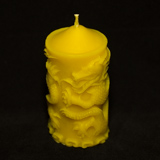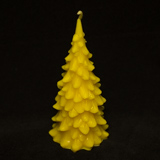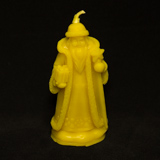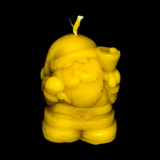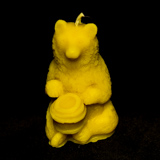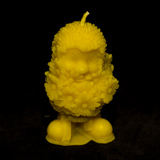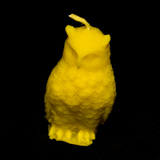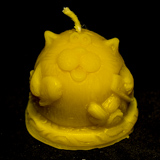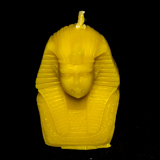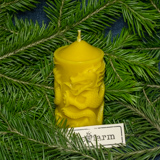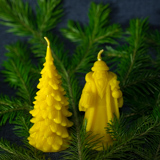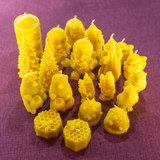How to make natural beeswax candles
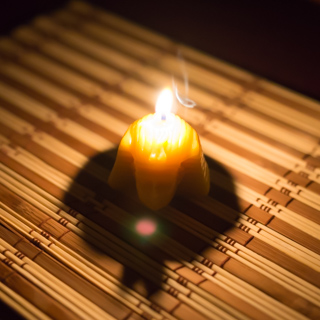 Everything fades in the winter. What do beekeepers do when the warm season is over and their bees are ready to winter? They clean, sanitize and store beekeeping equipment. They paint and repair their woodenware or purchase new ones. They build new hives, honey supers and frames. They miss the bees and worry about whether they'll winter well. They read books. And on the eve of Christmas and New Year's, they make candles from natural beeswax.
Everything fades in the winter. What do beekeepers do when the warm season is over and their bees are ready to winter? They clean, sanitize and store beekeeping equipment. They paint and repair their woodenware or purchase new ones. They build new hives, honey supers and frames. They miss the bees and worry about whether they'll winter well. They read books. And on the eve of Christmas and New Year's, they make candles from natural beeswax.
Beeswax is a very valuable natural product with many unique properties. Candles made out of beeswax have a pleasant golden color and a warm aroma with the scent of honey and flowers. They burn longer, brighter and cleaner than paraffin candles. In fact, they are natural aroma candles with the scent provided not by chemical additives but by the material itself. Making candles can be a great hobby that is very easy to learn. It does not require a lot of tools and you will quickly be able to make some excellent products.
It is worth mentioning that unlike natural beeswax, widely used paraffin can cause adverse health effects in the long term. Researchers from South Carolina State University have found that the fumes from paraffin wax candles contain poisonous and carcinogenic substances like toluene and benzene and produce a lot of black soot. For some people, paraffin wax candles can cause allergies or respiratory irritation. Also, commercially available candles can contain wicks with lead cores, which have the potential to generate indoor airborne lead concentrations of health concern. Lead wicks are banned in the USA. Furthermore, the chemical scents used in some candles are also questionable.
There are different ways to make beeswax candles. For example, candles can be rolled from beeswax sheets. Another way is by dipping the wick into melted wax until the candle becomes sufficiently thick. And finally, the most common method is to pour melted wax into various types of molds.
Can't wait to start making candles? You'll have to wait a little longer, because the next thing is a safety lecture and a video showing what happens when you try to put out burning oil with water.
What do I need to know about candle making safety?
Generally speaking, candle making is pretty safe. Once you understand the risks and what to do and not to do in the event of fire, making candles will become as safe as cross-stitching.
The melting point of wax is about 60-70°C (140-158°F). At 100°C (212°F), a white foam can appear on the surface of the wax. It happens because sometimes wax contains emulsified water due to its processing (filtering) in boiling water. There is nothing wrong with this and if you allow the wax to dehydrate, it will burn better and crackle less. At temperatures above 120°C (248°F), wax starts to evaporate, and after 204°C (400°F) it ignites!
Therefore, the basic safety rule is to control the melting temperature (get a thermometer if you are unsure). Do not put a bowl of beeswax directly on the stove and do not allow the wax temperature to go above 120°C (248°F). It should melt slowly. Do not pour water into the melted wax, as this will lead it to splatter. Wax burns as well as oil, so extinguishing it with water is strictly prohibited (this is what happens if you ignore this rule). If it catches on fire, use a fire extinguisher or sand. If you have nothing at hand, cover the top of the bowl with a dense and damp cloth. Keep this in mind, and always prepare extinguishing agents before you begin.
The safest way to melt beeswax is to use a double boiler. Use an electric heat source if possible, and be extra careful if you use a gas stove. Always make sure that the bottoms of the inner and outer pots are not in direct contact. Put a metal cookie cutter, a bunch of river stones of the same size or a heat resistant silicone kitchen mat into the bottom pot to make sure there is some space between the pots. Pour in more water as it boils and evaporates from the bottom pot. Do not fill the bowl with wax up to the edge, and do not let it spill onto the stove.
Wax melted in a double boiler has temperature about 100°C (212°F). Put on a pair of gloves to protect your hands from hot bowls and wax during the melting, filtering or filling the molds. Once the wax starts to melt in the double boiler, do not leave it unattended, whatever happens. Turn off TV, let the phone ring and the dog bark. If you want to walk away even for a minute, turn off the heat source.
Your working place should be spacious, comfortable and well ventilated, and have a water supply nearby. Optimize it for convenience and remove any clutter. Use stable bowls and equipment. Your favorite bathrobe with wide sleeves is certainly comfortable, but it is better to wear clothes that will not catch on any objects or hang in the wax. For more protection, you can wear an apron and gloves.
Do not hurry. Do not let children or pets enter your workplace and get in your way. They come equipped with endless curiosity, and although curiosity would not kill your cat in this case, he would not appreciate hot wax all over his fur. If you want your children to become familiar with the art of candlemaking, choose a day when you have plenty of time, and limit the equipment to the strict minimum needed for the project.
Eventually you are going to spill hot beeswax. It is wise to cover the table with a tablecloth or a sheet of thick paper. Also, it may be a good idea to cover the floor with a large piece of linoleum or old carpet (do not use newspapers or other slippery material). If you spill some wax on an uncovered surface, let it harden, then remove it with a plastic scraper and wipe the remnants with a cloth soaked in all-purpose cleaner. If you spill wax on your clothes or other fabric, put it in the freezer for about thirty minutes, then remove the fabric and scrape off the cold wax. Remove the rest by ironing it with a warm iron through a paper napkin. You can also try refined gasoline (which is used to refill lighters), as it dissolves the wax. Always remove any wax drops from the stove surface.
Do not wash double-boiler pots in hot water and generally avoid flushing wax residuals into the drain. It will become clogged, and instead of burning your new beautiful candles and enjoying the scents, you will need to become a plumber and do the dirty work of cleaning the drain. Not the best end to your day, right?
Do not leave burning candles unattended. Put them on a safe surface where no one can knock them off. Move candles away from curtains or any other flammable materials. Avoid placing them near open windows or in areas with vents or drafts. Always use candle stands and holders. Extinguish all candles when leaving a room or before going to sleep. Be sure the wick ember is no longer glowing.
Preparations
How to choose and prepare my working place
 If you are like me, you probably do not have a separate workroom where you can spill wax all over the place. So, the first thing you should do is to prepare your working place. Choose a room with constant temperature, water source, ventilation and lack of drafts. In urban conditions the most suitable place is your kitchen. Consider the arrangement of things for each phase of the process and optimize everything for convenience. Beeswax breaking and filtering, molds, containers, wicks, finished candles, the surplus wax – all these things need space.
If you are like me, you probably do not have a separate workroom where you can spill wax all over the place. So, the first thing you should do is to prepare your working place. Choose a room with constant temperature, water source, ventilation and lack of drafts. In urban conditions the most suitable place is your kitchen. Consider the arrangement of things for each phase of the process and optimize everything for convenience. Beeswax breaking and filtering, molds, containers, wicks, finished candles, the surplus wax – all these things need space.
First, you need a large horizontally aligned table. I'm sure you are a very accurate person, but do not even think it would be possible to keep the table clean from beeswax. Cover it with something like newspapers, wrapping paper, thick tablecloth or old towels. Also lay something on the floor, like an old carpet, sheet of linoleum or piece of cardboard. Make sure there are enough shelves for your molds, essential oils, candles, tools and containers.
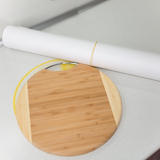 Second, you'll need an old cutting board or a piece of plywood to chop the wax on. Also, you'll need another wooden board or silicone mat to hold your hot wax container.
Second, you'll need an old cutting board or a piece of plywood to chop the wax on. Also, you'll need another wooden board or silicone mat to hold your hot wax container.
Third, you need something to melt the wax. There are several approaches. The easiest and safest one is to use a double boiler heated on the stove. A more costly option is to use a rice cooker, slow cooker or multi cooker (with mandatory temperature control!) or improved Presto multi cooker. The most expensive option is to use dedicated wax-melting equipment, specifically designed to melt wax in large quantities.
To make a few candles, the most optimal method is to use a double boiler. It makes no sense to spend a lot of money on expensive equipment. To protect the stove from beeswax spills, your best bet is just to try to be accurate (trying to cover the stove with something is dangerous).
Fourth, have a water source nearby. You will need it for your double boiler (it may be necessary to pour water multiple times). In addition, some types of candles (e.g., multi layer) require rapid cooling.
Fifth, stock up on paper napkins. They are useful for wiping spilled beeswax before it cools down.
What equipment do I need to melt and filter beeswax?
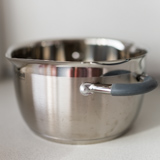
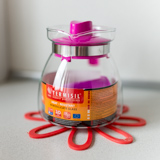 To melt the wax, you need to make a double boiler. Get a large external metal pot and a smaller internal bowl. For an internal bowl you can use a heat-resistant glass pot (like a Pyrex measuring jug), tin can or another pot made from stainless steel, enamelled steel or aluminum. Any contact with iron, zinc, brass or copper spoils wax color. Of course, you can use your new and shiny kitchen pots to make a double boiler, but be aware that they will be covered with beeswax and you'll definitely remember the subsequent cleaning process :) Bottoms of internal and external pots should not have contact with each other, so place a metal cookie cutter, several round river stones of the same size or a heat-resistant silicone kitchen mat between them.
To melt the wax, you need to make a double boiler. Get a large external metal pot and a smaller internal bowl. For an internal bowl you can use a heat-resistant glass pot (like a Pyrex measuring jug), tin can or another pot made from stainless steel, enamelled steel or aluminum. Any contact with iron, zinc, brass or copper spoils wax color. Of course, you can use your new and shiny kitchen pots to make a double boiler, but be aware that they will be covered with beeswax and you'll definitely remember the subsequent cleaning process :) Bottoms of internal and external pots should not have contact with each other, so place a metal cookie cutter, several round river stones of the same size or a heat-resistant silicone kitchen mat between them.
Your beeswax should be already clean, but if not, you can use the following method for initial filtering. Even after that, it is necessary to filter the wax again before pouring it into the molds. This will help to get rid of foreign matter and other impurities contained in the wax. For this process you need another container and nylon fabric or a paper cone paint strainer.
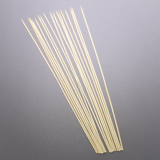 To control the wax-melting process, you need some bamboo skewers or Chinese chopsticks.
To control the wax-melting process, you need some bamboo skewers or Chinese chopsticks.
How to choose candle molds
Since this article is about molded candles, you need to get several candle molds. There are different materials they are made from:
- Aluminum. These molds are generally seamless and are suitable for simple pillar candles. The aluminum provides high release capabilities, but may require applying some release spray or powder. They are heat-resistant and give a nice, glossy finish.
- Polycarbonate. These molds are lightweight and transparent, come in both one-piece and two-piece systems, allow you to make more complex-shaped candles and give a good gloss. Polycarbonate molds are not flexible.
- Polyurethane rubber. This is flexible and durable enough, but its components are toxic and the final mold cannot be used at temperatures over 80°C (176°F).
- Silicone rubber. Heat-resistant (up to 200°C / 392°F), elastic, non-toxic and the candles are very easy to extract (you do not need any mold release). The disadvantages are: low durability, mold surface is easy to damage, and need to be stored properly to avoid deformation. Moreover, if you want to make scented candles by adding any fragrances, their odor may be absorbed by the silicone and it will be difficult to get rid of the scent. In general, one mold will last for hundreds of pours if used correctly.
![]() We will use silicone molds due to the their popularity and rich expressiveness. There are lots of online stores where you can buy them, for example: vanyulay.com, amazon.com or ebay.com.
We will use silicone molds due to the their popularity and rich expressiveness. There are lots of online stores where you can buy them, for example: vanyulay.com, amazon.com or ebay.com.
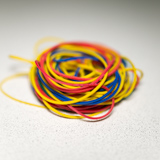 It is worth mentioning that silicone molds aren't cheap. Your best bet is to choose the most popular shapes in which you plan to cast more than one candle. You can also try to make your own molds from raw silicone rubber. It will require some patience and artistic skill to produce unique molds, or you'll need existing templates to make molds from. You can find good tutorial on blog.polytek.com.
It is worth mentioning that silicone molds aren't cheap. Your best bet is to choose the most popular shapes in which you plan to cast more than one candle. You can also try to make your own molds from raw silicone rubber. It will require some patience and artistic skill to produce unique molds, or you'll need existing templates to make molds from. You can find good tutorial on blog.polytek.com.
Besides molds themselves, you'll need several rubber bands and a piece of wire to make wick holders.
Do I need any tools?
 To crush beeswax, you will need a hammer, a chisel or flat screwdriver and a knife. To cut a wick you need scissors, and to cut a wire for wick holders, you'll need wire cutters. Also, it is good to have a heat gun or gas turbo lighter to level out the bottoms of the candles after they have cooled.
To crush beeswax, you will need a hammer, a chisel or flat screwdriver and a knife. To cut a wick you need scissors, and to cut a wire for wick holders, you'll need wire cutters. Also, it is good to have a heat gun or gas turbo lighter to level out the bottoms of the candles after they have cooled.
What expendable candlemaking supplies do I need to stock up on?
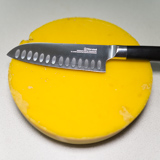 Beeswax is the primary ingredient. If you want to estimate the required amount, you can do the following trick. Take a large measuring jug, fill each of the candle molds with water and pour into the mug. The density of wax is approximately equal to the density of water and can be easily translated one-to-one in volume. For example, if your measuring jug contains one litre of water, it means that you need to take approximately one kilogram of wax. It is very convenient to use weight as a base measure, because wax can come not only in solid bricks, but also in crushed form where it is difficult to measure its volume.
Beeswax is the primary ingredient. If you want to estimate the required amount, you can do the following trick. Take a large measuring jug, fill each of the candle molds with water and pour into the mug. The density of wax is approximately equal to the density of water and can be easily translated one-to-one in volume. For example, if your measuring jug contains one litre of water, it means that you need to take approximately one kilogram of wax. It is very convenient to use weight as a base measure, because wax can come not only in solid bricks, but also in crushed form where it is difficult to measure its volume.
 The second most important thing is the wick. Good eco-friendly wicks contain no metal cores and are made from braided cotton. The thickness of the wick depends on the material and the diameter of the candle. The larger the candle diameter, the thicker the wick should be. If the wick is too thick, the flame will burn too brightly and the candle can melt. If the wick is too thin, it can become saturated with wax and cease to burn. Beeswax is more viscous material than paraffin and typically requires thicker wicks. The thickness can vary between 1 to 4 millimeters; in this tutorial I use 2mm wick. If you dip the wick in the melted wax, the candle will burn longer and stronger. You can find recommendations to soak the wick in boric acid and various metal salts to produce a colored flame, but for natural beeswax candles it is better to avoid any chemicals.
The second most important thing is the wick. Good eco-friendly wicks contain no metal cores and are made from braided cotton. The thickness of the wick depends on the material and the diameter of the candle. The larger the candle diameter, the thicker the wick should be. If the wick is too thick, the flame will burn too brightly and the candle can melt. If the wick is too thin, it can become saturated with wax and cease to burn. Beeswax is more viscous material than paraffin and typically requires thicker wicks. The thickness can vary between 1 to 4 millimeters; in this tutorial I use 2mm wick. If you dip the wick in the melted wax, the candle will burn longer and stronger. You can find recommendations to soak the wick in boric acid and various metal salts to produce a colored flame, but for natural beeswax candles it is better to avoid any chemicals.
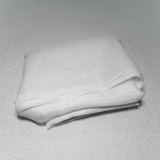
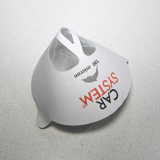 To filter the wax you will need a piece of fine nylon fabric. It will become clogged with wax after filtering (and is hard to reuse again), so get big enough piece for your candle making needs. It is also possible to use a paper cone paint strainer.
To filter the wax you will need a piece of fine nylon fabric. It will become clogged with wax after filtering (and is hard to reuse again), so get big enough piece for your candle making needs. It is also possible to use a paper cone paint strainer.
Let's make some candles!
Ready? Let's begin! To shoot the entire process for this article, I have borrowed a camera, a tripod, and also a couple of light sources.
How to make wick holders
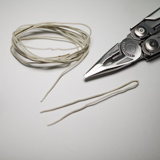 There are different ways to secure a candle wick. You can use clothespins, hairclips and even special wick holders. I took a piece of wire, cut it into 15cm-long pieces and bent them in half. Total holder length should be equal to or greater than the diameter of the mold. To fix the wick, place it in the middle of the holder, twist the wire and adjust the wick tension to straighten it.
There are different ways to secure a candle wick. You can use clothespins, hairclips and even special wick holders. I took a piece of wire, cut it into 15cm-long pieces and bent them in half. Total holder length should be equal to or greater than the diameter of the mold. To fix the wick, place it in the middle of the holder, twist the wire and adjust the wick tension to straighten it.
When the wire was over, I began to use bamboo skewers fastened together with rubber bands. You can come up with your own unique ways to secure the wick; feel free to share them in the comments.
Assembling silicone molds
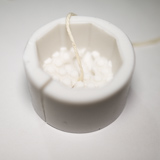
 During the manufacturing process, candle molds are already slit to extract the original shape. Fit the wick into the mold slit and center its end in the middle of the candle top (bottom of the mold). The slit has the tendency to grow so be gentle – there is no need to cut the mold in half! It is OK to have a length of extra wick at the bottom.
During the manufacturing process, candle molds are already slit to extract the original shape. Fit the wick into the mold slit and center its end in the middle of the candle top (bottom of the mold). The slit has the tendency to grow so be gentle – there is no need to cut the mold in half! It is OK to have a length of extra wick at the bottom.
![]()
![]()
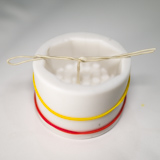 To prevent wax from leaking, secure the mold with rubber bands (two or more, depending on the mold height). The density and viscosity of beeswax is greater than paraffin, so if the mold walls are reasonably thick there is no need to apply any sealing material to the slit. After the mold is assembled, align the silicone cut to prevent "pressure ridge" on the candle.
To prevent wax from leaking, secure the mold with rubber bands (two or more, depending on the mold height). The density and viscosity of beeswax is greater than paraffin, so if the mold walls are reasonably thick there is no need to apply any sealing material to the slit. After the mold is assembled, align the silicone cut to prevent "pressure ridge" on the candle.
To secure the wick, place it in the middle of the holder, twist the wire and adjust the wick tension to straighten it.
Making a double boiler for wax-melting
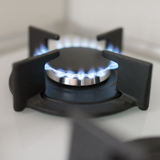
 Now is the time to prepare a double boiler. Fill a pot one-third full with water and put on the stove. Too much water can lead to overflow after placing the inner bowl into the pot, and too little will lead to a slower melting process and you will have to add more water as it evaporates. While the water boils, let's take a hammer and make some noise (hello roommates/neighbors!).
Now is the time to prepare a double boiler. Fill a pot one-third full with water and put on the stove. Too much water can lead to overflow after placing the inner bowl into the pot, and too little will lead to a slower melting process and you will have to add more water as it evaporates. While the water boils, let's take a hammer and make some noise (hello roommates/neighbors!).
Crushing beeswax
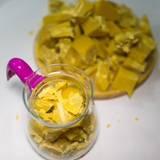
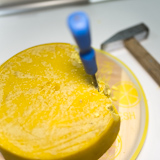 Using a hammer, chisel or screwdriver and a knife, split the wax into chunks. The smaller the pieces, the faster they will melt, but if you take it too far, you'll spend more time crushing beeswax than melting it. To simplify the process, you can freeze the wax to make it more fragile. It is better to crush all your wax at once in order to not repeat this process again – and do not hammer the table with cooling candles on it when you need to add more wax to the boiler.
Using a hammer, chisel or screwdriver and a knife, split the wax into chunks. The smaller the pieces, the faster they will melt, but if you take it too far, you'll spend more time crushing beeswax than melting it. To simplify the process, you can freeze the wax to make it more fragile. It is better to crush all your wax at once in order to not repeat this process again – and do not hammer the table with cooling candles on it when you need to add more wax to the boiler.
Melting beeswax
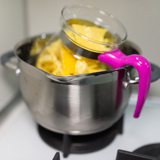
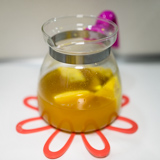 To prevent direct contact of the internal and external pots of the double boiler, place a metal cookie cutter, several round river stones of the same size or a heat-resistant silicone kitchen mat between them. Fill the internal heat-resistant glass pot with crushed beeswax and place it into the pot with boiling water. You can reduce the cooker temperature to slow down boiling water evaporation.
To prevent direct contact of the internal and external pots of the double boiler, place a metal cookie cutter, several round river stones of the same size or a heat-resistant silicone kitchen mat between them. Fill the internal heat-resistant glass pot with crushed beeswax and place it into the pot with boiling water. You can reduce the cooker temperature to slow down boiling water evaporation.
During the melting process, occasionally check if the wax has completely melted using a bamboo skewer. As the wax melts, you will probably need to add more to fill the bowl. If you do not plan to add any essential oils or dyes, I do not recommend stirring the wax. Sooner or later it will melt anyway, and any impurities and foreign matter will sink to the bottom (this simplifies the filtering process). Periodically add water to replace water lost to evaporation (remove the inner pot when you do it; this will prevent you from accidentally spilling water into the hot wax, which is dangerous).
Filtering beeswax
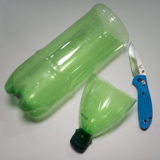
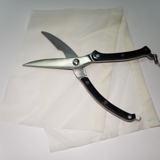
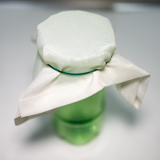 You need another vessel to filter wax into. I used a plastic bottle, but in the end it warped due to the heat of the wax and therefore it is better to choose something else. Cut the top off the plastic bottle using a sharp knife or scissors.
You need another vessel to filter wax into. I used a plastic bottle, but in the end it warped due to the heat of the wax and therefore it is better to choose something else. Cut the top off the plastic bottle using a sharp knife or scissors.
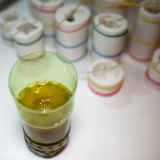
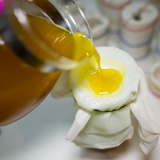 To make a filter, cut a piece of nylon fabric or cheesecloth, fold it twice, place over the top of the bottle and secure it with a rubber band. This can be even simpler if you have a paper cone paint strainer.
To make a filter, cut a piece of nylon fabric or cheesecloth, fold it twice, place over the top of the bottle and secure it with a rubber band. This can be even simpler if you have a paper cone paint strainer.
Push the nylon cloth with the stick at the center and carefully pour the melted wax into the bottle. The melting point of beeswax is lower than the double boiler's temperature, so you have enough time to filter and pour it before the wax cools down from 100°C (212°F) to 70°C (158°F) and becomes solid again. Nevertheless, do not wait too long before you pour the filtered beeswax into prepared molds.
Pouring beeswax
![]()
![]()
![]()
![]() Carefully (the wax is hot!) pour beeswax into the molds, up to the edge. Pour any extra filtered wax back to the melting container to keep it liquid. Wait for 10-20 minutes until the candles cool a bit and the wax concaves. Using a thin wooden skewer, poke two or three relief holes in the wax around the wick. Re-filter some more wax and fill the candles to the top again to fill these holes, concaves and any cracks.
Carefully (the wax is hot!) pour beeswax into the molds, up to the edge. Pour any extra filtered wax back to the melting container to keep it liquid. Wait for 10-20 minutes until the candles cool a bit and the wax concaves. Using a thin wooden skewer, poke two or three relief holes in the wax around the wick. Re-filter some more wax and fill the candles to the top again to fill these holes, concaves and any cracks.
Cooling candles
Candle cooling can take anywhere from two to six hours, depending on the candle size. To prevent beeswax cracks, allow the candles to cool slowly and do not try to speed up the process using cool water or the fridge. Just leave your candles to sit in the same room.
If you've filled all the molds, it is time to turn off the stove and take a break. In the meantime, you may spend some time browsing this blog, for example the "Resources" section.
Extracting candles
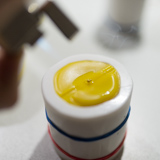
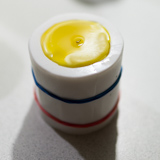

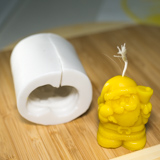 First, you need to remove the wick holder. Using the knife, carefully separate it from the beeswax and then remove it. Trim the wick on the bottom of the candle with scissors.
First, you need to remove the wick holder. Using the knife, carefully separate it from the beeswax and then remove it. Trim the wick on the bottom of the candle with scissors.
Most likely the candle base will not be very flat due to wax drips or traces of the wick holder. Use a heat gun or turbo lighter to reheat the base and flatten the beeswax.
After the wax cools down, remove the rubber bands and gently extract the candle, trying not to break the mold further along the slit. Isn't the candle beautiful? Stay tuned, you will find more photos at the end of the article.
Preparing the candle wick
All that is left is to cut off the top end of the wick (leave about 1 cm in length) and stick it into the melted wax so it ignites easier.
What to do with the leftover beeswax?
If you still have some wax, melt it, assemble the molds again and repeat the process until you have enough candles. You can leave any wax remnants in the melting pot until next time.
Labelling and packaging
 Stickers, tags, labels and packaging is the most creative stage of candlemaking, the last touch before you get a finished product. It can vary a lot depending on your imagination, design skills and budget. I typically pick a small tag with my logo and tie it with a thin hemp cord directly to the candle. It is also possible to glue your label to the candle bottom, or leave some extra wick, put it through label hole and make a knot. If the candle is smooth, you can wrap it with a paper strip with a logo or text. And the most exclusive option is a cardboard or wooden box with some creative graphics. You can look for some inspiration here.
Stickers, tags, labels and packaging is the most creative stage of candlemaking, the last touch before you get a finished product. It can vary a lot depending on your imagination, design skills and budget. I typically pick a small tag with my logo and tie it with a thin hemp cord directly to the candle. It is also possible to glue your label to the candle bottom, or leave some extra wick, put it through label hole and make a knot. If the candle is smooth, you can wrap it with a paper strip with a logo or text. And the most exclusive option is a cardboard or wooden box with some creative graphics. You can look for some inspiration here.
Beeswax candle photos
